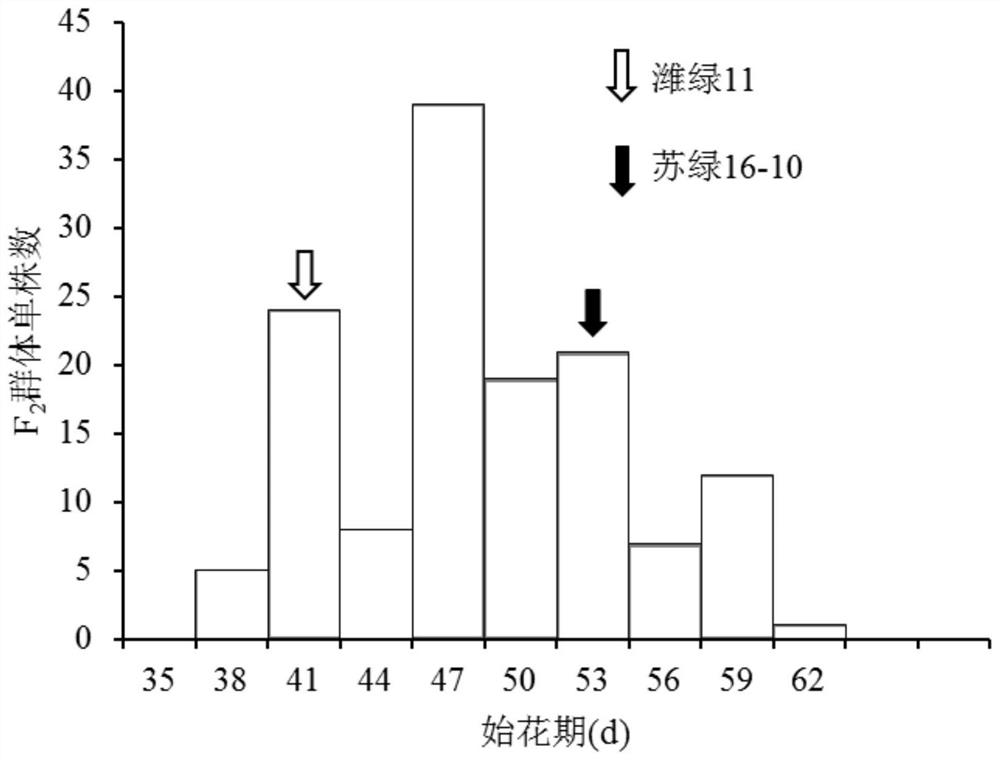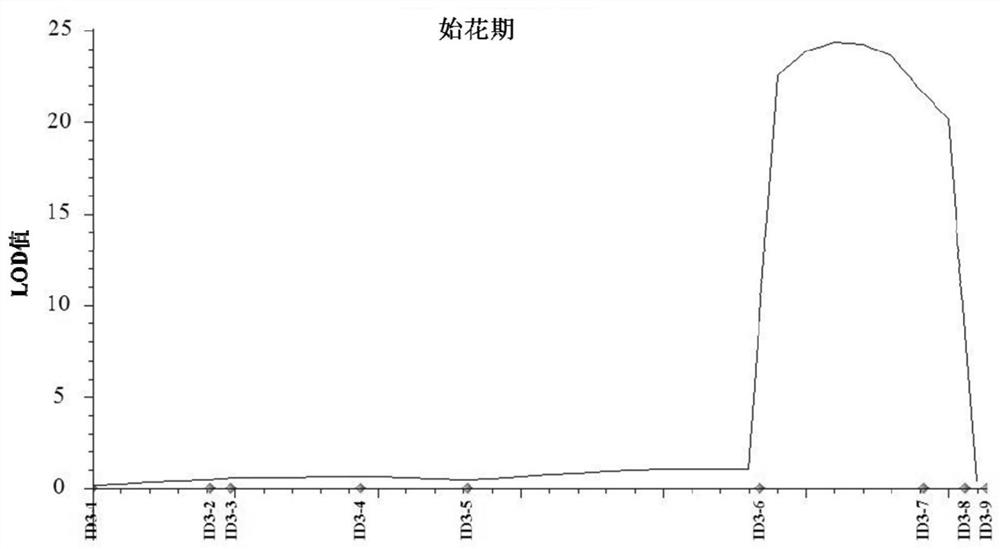Main effect QTL related to mung bean early flowering stage, molecular marker and application thereof
A technology of molecular markers and flowering stage, which is applied in the determination/inspection of microorganisms, DNA/RNA fragments, recombinant DNA technology, etc., can solve the problems of time-consuming and laborious identification of phenotypes, and weak genetic research, so as to reduce the workload of breeding , avoid time-consuming and labor-intensive, stable results
- Summary
- Abstract
- Description
- Claims
- Application Information
AI Technical Summary
Problems solved by technology
Method used
Image
Examples
Embodiment 1
[0031] This example provides a major QTL related to the first flowering stage of mung bean. The major QTL locus is located between markers ID3-6 and ID3-7 on chromosome 3, and its physical location is 7195kb-9169kb. And, in F 2 In the population, the LOD value of the main effect QTL was 24.31, the additive effect value was 7.04, the dominant effect value was 1.02, and the contribution rate was 52.55%. Next, this embodiment describes the determination of the main QTL.
[0032]Firstly, construct mung bean segregation populations at flowering stage. The mung bean variety Weilu 11 with early flowering and purple stems was selected as the male parent, and the mung bean variety Sulu 16-10 with late-maturing green stems was used as the female parent to prepare a hybrid combination. The days of first flowering of Weilu 11 were 41 days, and the days of first flowering of Sulu 16-10 were 54 days. Because Sulu 16-10 has a late flowering period, it can be sown 15 days in advance. When...
Embodiment 2
[0039] This example provides a main effect QTL related to the first flowering stage of mung bean, and narrows the position of the main effect QTL qDFF3 in Example 1 to between the markers R3-15 and R3-19 of chromosome 3, and the physical position is 8504kb~ 8674kb, the LOD value is 61.17, the additive effect value is 8.73, the dominant effect value is 0.34, and the contribution rate is as high as 84.42%. In this example, on the basis of Example 1, the verification of the main QTL qDFF3 in flowering stage is completed and the QTL interval is further narrowed.
[0040] QTL identification usually requires years of phenotypic surveys and QTL analysis data. If a QTL can be detected multiple times, it is a stable genetic QTL locus, which has important breeding significance. In order to verify the main effect QTL qDFF3 of mung bean flowering stage, this example uses F 2 F produced by population selfing 3 Populations were subjected to phenotypic identification and QTL analysis. In ...
Embodiment 3
[0042] This embodiment provides a primer pair of molecular markers related to the mung bean flowering stage, which contains a pair of molecular markers; one of the molecular markers is closely linked to the main QTL related to the mung bean flowering stage in Example 2, and is located at the QTL on the left side, and is the InDel marker R3-15, which is located at 8504kb on the third chromosome, and the front and rear primer sequences are shown in the sequence table Seq ID NO.1 and the sequence table Seq ID NO.2; wherein another molecular marker is the same as that in Example 2 The main QTL related to the first flowering stage of mung bean is closely linked, located on the right side of the QTL, and is the InDel marker R3-19, located on the third chromosome 8674kb, the primer sequences before and after are shown in the sequence table Seq ID NO.3 and the sequence table Seq ID Shown in NO.4.
PUM
| Property | Measurement | Unit |
|---|---|---|
| volume | aaaaa | aaaaa |
Abstract
Description
Claims
Application Information
 Login to View More
Login to View More - R&D
- Intellectual Property
- Life Sciences
- Materials
- Tech Scout
- Unparalleled Data Quality
- Higher Quality Content
- 60% Fewer Hallucinations
Browse by: Latest US Patents, China's latest patents, Technical Efficacy Thesaurus, Application Domain, Technology Topic, Popular Technical Reports.
© 2025 PatSnap. All rights reserved.Legal|Privacy policy|Modern Slavery Act Transparency Statement|Sitemap|About US| Contact US: help@patsnap.com



